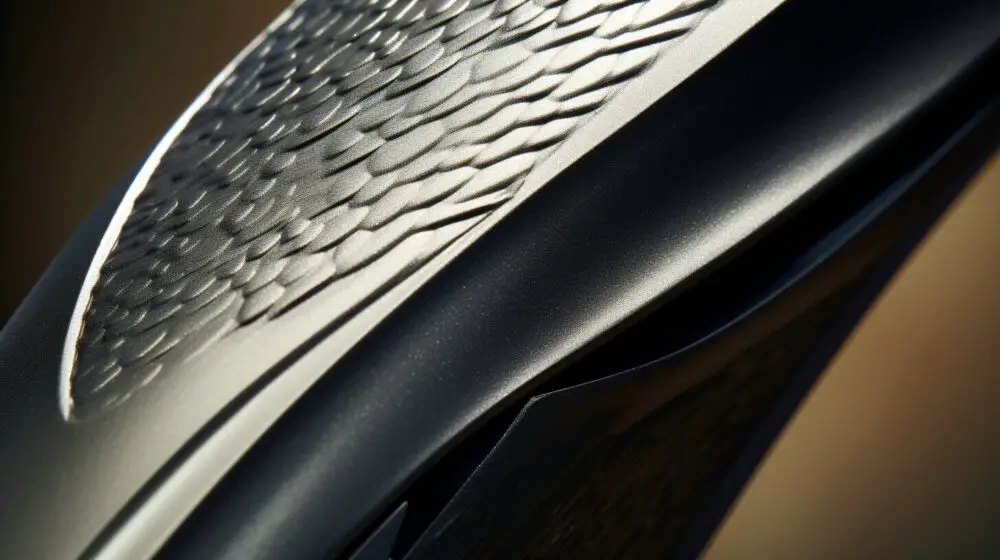If you don’t have a spoke wrench, don’t worry! There are several ways to tighten bike spokes using alternative tools and techniques. Whether you prefer using an adjustable wrench or pliers, or if you want to try the method of using two straight spokes, we’ve got you covered. In this article, we’ll explore various methods and tools you can use to keep your bike spokes tight and in optimal condition.
Key Takeaways:
- Using an adjustable wrench or pliers is a viable method for tightening bike spokes without a spoke wrench.
- Two straight spokes can be used to pull and tighten the spokes effectively.
- Alternative tools such as a screwdriver, household nail, or C-clamp can also be used to tighten bike spokes.
- Regularly checking the tension of each spoke, comparing with other bikes, and replacing weak or damaged spokes is important for optimal performance.
- Choosing the right size wrench or alternative tool is crucial to avoid damaging the spokes.
Using an Adjustable Wrench or Pliers
One of the simplest ways to tighten bike spokes without a spoke wrench is by using an adjustable wrench or a pair of pliers. These versatile tools can easily turn the nut on top of the spoke nipple, allowing you to adjust the tension of the spokes with ease. Here’s how you can do it:
- Start by locating the spoke nipple, which is the small nut that connects the spoke to the rim of the bike wheel. It can be found on the outer side of the rim, near the tire.
- Place the adjustable wrench or pliers on the spoke nipple, ensuring a firm grip.
- Gently turn the nut clockwise to tighten the spoke or counterclockwise to loosen the spoke. Be careful not to overtighten or overtighten the spoke, as it could lead to damage.
- Repeat this process for each spoke, ensuring that they are evenly tensioned.
Using an adjustable wrench or pliers gives you the flexibility to adjust the tension of your bike spokes without the need for a specialized spoke wrench. Just remember to apply the right amount of tension and check regularly for any loose spokes.
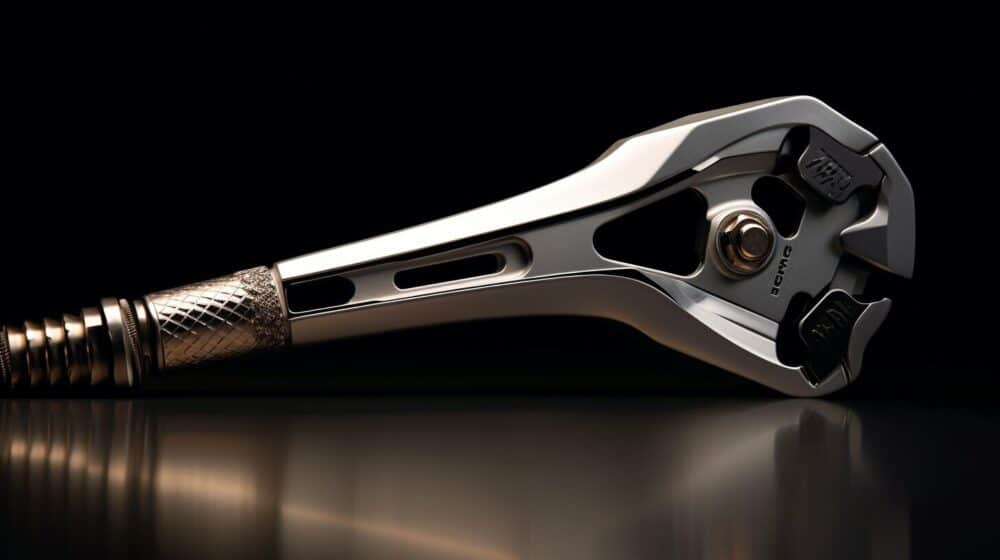
Using Two Straight Spokes
If you don’t have a spoke wrench or an adjustable wrench, you can still tighten your bike spokes by using two straight spokes. This method is effective and easy to do, allowing you to maintain the tension on your spokes without specialized tools.
To begin, find two straight spokes that are the same length as the spokes you want to tighten. Insert one spoke into the hole in the spoke nipple and hold it in place while you insert the other spoke into the hole directly across from it. These two spokes will act as your makeshift wrench.
Now, pull the two straight spokes away from each other, applying tension to the spoke nipple. This will tighten the spoke and increase its tension. Repeat this process for each spoke you want to tighten, ensuring that you apply equal pressure to each pair of spokes.
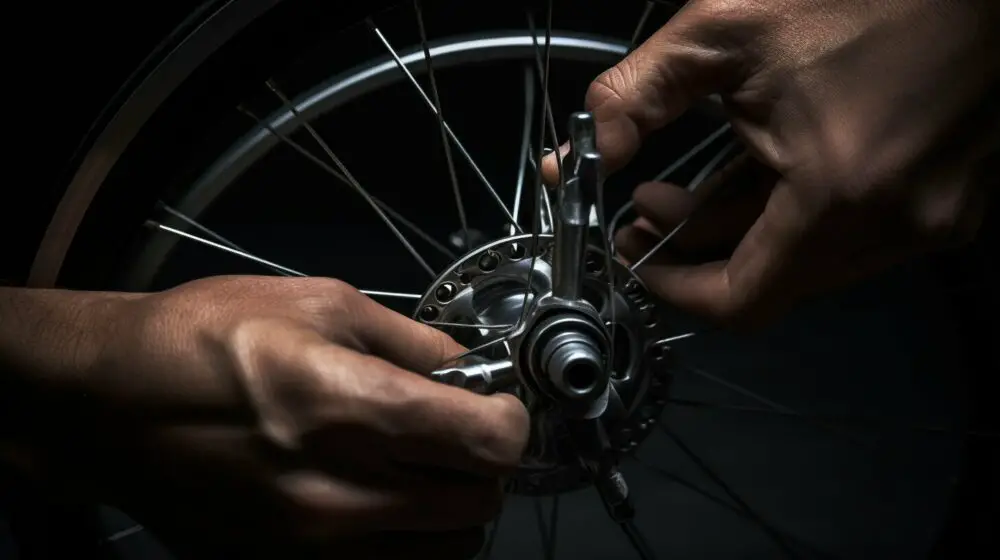
Remember, it is essential to use caution when tightening your spokes. Apply gradual pressure and check the tension regularly to avoid over tightening and potentially damaging your wheel. Using two straight spokes is a convenient and accessible method for tightening your bike spokes when you don’t have a spoke wrench available.
Alternative Tools for Tightening Bike Spokes
In addition to wrenches, there are several other tools you can use to tighten your bike spokes without a spoke wrench. These tools can be found around the house or easily purchased at a hardware store. Let’s explore some of the alternatives:
Screwdriver: A flat-head or Phillips-head screwdriver can be used to tighten and adjust spoke nipples. Choose a screwdriver that fits comfortably into the spoke nipple to avoid damaging the threads.
Household Nail: If you don’t have a screwdriver on hand, a household nail can serve the purpose. Simply position the nail’s tip into the spoke nipple and turn it clockwise to tighten the spoke.
C-Clamp, Allen Wrench, and Cone Spanner: These tools provide a firm grip and leverage to tighten the spokes effectively. The C-clamp can be used to hold the spoke while using an Allen wrench or cone spanner to turn the spoke nipple.
Hammer, Small Tire Lever, Vice, and Rubber Band: These tools can be used in combination to secure the spoke and provide the necessary tension. Use the rubber band to hold the spoke in place while using a hammer, small tire lever, or vice to turn the spoke nipple clockwise.

Remember, when using alternative tools, it’s essential to apply the right amount of tension to avoid over-tightening or damaging the spokes. Regularly check the tension of each spoke, comparing your bike to others for loose spokes. Adjust tire pressure for optimal comfort while riding, and replace weak or damaged spokes promptly to ensure the integrity of your bike’s wheel.
By using the correct size wrench or alternative tool, and following proper techniques for truing a bike wheel, you can maintain a safe and efficient ride. Start with the worst issues first, utilizing visual and tactile feedback to make small adjustments until the wheel runs true. With these alternative tools and methods, you’ll be able to tighten your bike spokes without a spoke wrench and keep your wheels in top shape.
Importance of Regular Spoke Tension Checks
Ensuring proper spoke tension is crucial for maintaining a safe and reliable bike, so it’s important to regularly check the tension of each spoke. Loose spokes can lead to a host of issues, including wheel wobbling, poor handling, and increased risk of spoke breakage. By performing regular tension checks, you can identify and address any potential problems before they become more serious.
One effective way to gauge spoke tension is by comparing your bike to others. Observe the wheels of similar bikes and take note of the tension in their spokes. Pay attention to the amount of play or slackness in the spokes. If you notice a significant difference between your bike and others, it may indicate that your spokes require adjustment.
Additionally, it’s important to consider your riding style and adjust tire pressure accordingly. Higher tire pressure can lead to increased spoke tension, while lower pressure can decrease tension. Finding the right balance for your needs can help improve overall bike performance and comfort.
Regular spoke tension checks also provide an opportunity to identify weak or damaged spokes. Weak spots or visible signs of damage, such as bends or kinks, should be addressed promptly to prevent further issues. Replacing weak or damaged spokes will help maintain the integrity of the wheel and ensure a smoother ride.

| Benefits of Regular Spoke Tension Checks | Steps for Checking Spoke Tension |
|---|---|
|
|
Proper Techniques for Truing a Bike Wheel
Truing a bike wheel is essential to ensure it spins round and straight, and with the right techniques, you can do it without a spoke wrench. To start, you’ll need visual and tactile feedback to identify any issues with the wheel’s roundness or straightness. Look for any wobbles or uneven spots as you spin the wheel.
Begin by focusing on the worst issues first – the areas where the wheel deviates the most from being round or straight. Use your fingers or a tool to make small adjustments to the tension of individual spokes in these areas. Gradually tighten or loosen the spokes to move the wheel closer to its desired shape.
As you make adjustments, continue to spin the wheel and observe the changes. The goal is to achieve an even, balanced rotation without any visible wobbles. Be patient and make subtle adjustments until the wheel runs true. Remember that it’s better to make multiple small adjustments rather than one big change, as this allows for more precise fine-tuning of the wheel’s alignment.
| Tools for Truing a Bike Wheel | Pros | Cons |
|---|---|---|
| Screwdriver | Accessible and easy to use | May not fit all spoke nipples |
| Household nail | Can be shaped to fit specific nipples | May require modification |
| C-clamp | Provides strong grip on the spoke | May leave marks on the spoke |
| Allen wrench | Fits most modern spoke nipples | Requires an Allen key set |
Remember, truing a bike wheel without a spoke wrench may require alternative tools like a screwdriver, household nail, C-clamp, or Allen wrench. Each tool has its pros and cons, so choose the one that suits your needs best. And always remember to use the correct size tool to avoid damaging the spokes.
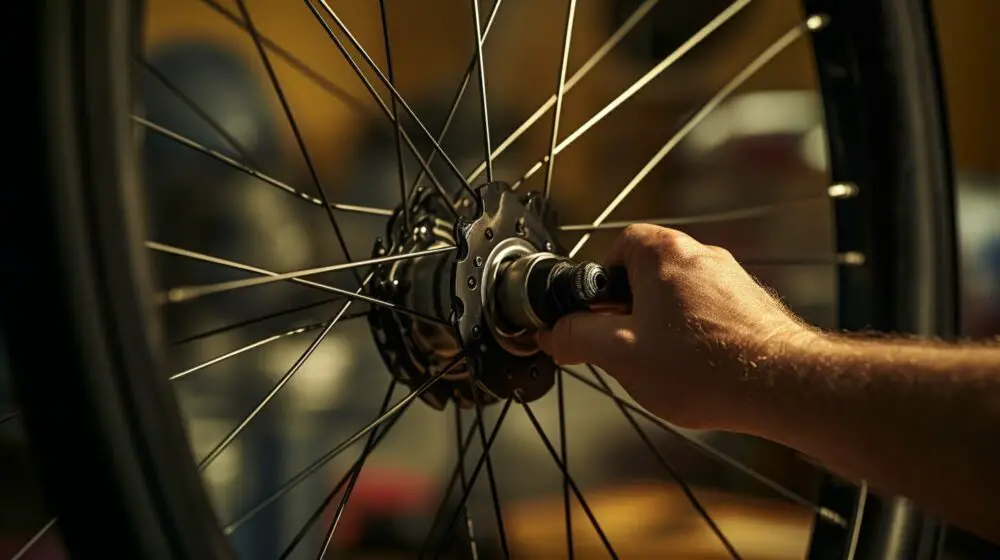
Choosing the Right Size Wrench or Alternative Tool
When tightening bike spokes without a spoke wrench, using the right size wrench or alternative tool is crucial to avoid damaging the spokes. While there are various tools that can be used, it’s important to select the appropriate size to ensure a proper fit and prevent any unnecessary strain on the spokes.
One option is to use an adjustable wrench or pliers, which can provide a secure grip on the spoke nipple. This allows you to turn the nut and tighten the spokes effectively. However, it’s important to note that using an adjustable wrench or pliers may require more caution as they may not provide the same level of control as a dedicated spoke wrench.
If you don’t have an adjustable wrench or pliers on hand, there are alternative tools that can be used. These include a screwdriver, household nail, C-clamp, Allen wrench, cone spanner, hammer, small tire lever, vice, or even a rubber band. It’s essential to choose a tool that fits securely onto the spoke nipple and allows for accurate tightening without causing any damage.
Remember, when using any alternative tool, it’s crucial to apply pressure evenly and gradually to avoid exerting excessive force on the spokes. This can help prevent damage and ensure a proper adjustment. Regularly checking the tension of each spoke, comparing your bike to others for loose spokes, adjusting tire pressure for comfort, and replacing weak or damaged spokes are all essential maintenance practices to keep your bike in optimal condition.
Truing a wheel is another important aspect of bike maintenance. This involves aligning the wheel’s rim to ensure it is both round and straight. Visual and tactile feedback are key to identifying any irregularities. Start by addressing the worst issues first, making small adjustments, and progressively working your way around the wheel until it runs true.
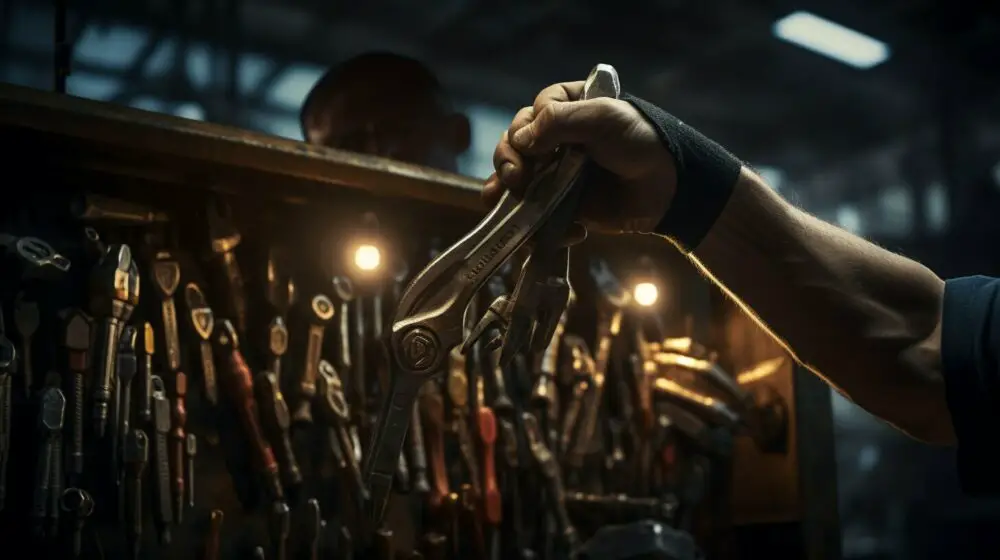
| Tool | Pros | Cons |
|---|---|---|
| Adjustable wrench or pliers | Can provide a secure grip, widely available | May lack precision, potential for damage if not used carefully |
| Screwdriver | Easy to find, can fit into tight spaces | May not provide enough leverage, risk of slipping |
| Household nail | Convenient in a pinch | Limited control, potential for damage |
| C-clamp | Secure grip, adjustable tension | Bulky, may require additional tools |
| Allen wrench | Precision fit for specific spoke nipples | Limited versatility, may require multiple sizes |
Conclusion
By using the alternative methods and tools discussed in this article, you can confidently tighten your bike spokes without a spoke wrench. If you don’t have a spoke wrench on hand, don’t worry. There are plenty of other options available to help you keep your bike in top condition.
An adjustable wrench or pliers can be used to turn the nut on top of the spoke nipple, providing a viable solution for tightening your bike spokes. Additionally, using two straight spokes and pulling them away from each other is another effective method for achieving the desired tension.
If you’re looking for alternative tools, you have a range of options to choose from. You can use a screwdriver, household nail, C-clamp, Allen wrench, cone spanner, hammer, small tire lever, vice, or even a rubber band. Each tool has its unique benefits and considerations, so pick the one that works best for you.
Remember to regularly check the tension of each spoke, comparing your bike to others for loose spokes. Adjusting tire pressure for comfort and replacing weak or damaged spokes are essential for maintaining a safe and smooth ride. Additionally, choosing the right size wrench or alternative tool is crucial to avoid damaging the spokes and ensuring effective tightening.
When truing your bike wheel, rely on visual and tactile feedback to identify and address issues. It’s recommended to start with the worst issues first, making small adjustments until the wheel runs true. This approach will help you achieve the desired roundness and straightness for optimal performance.
With the knowledge gained from this article, you can confidently maintain your bike’s spoke tension without the need for a spoke wrench. So, get ready to hit the road and enjoy a well-tuned ride!
FAQ
Q: Can I tighten bike spokes without a spoke wrench?
A: Yes, there are several alternative methods that can be used to tighten bike spokes without a spoke wrench.
Q: How can I tighten bike spokes using an adjustable wrench or pliers?
A: You can use an adjustable wrench or pliers to turn the nut on top of the spoke nipple and tighten the spokes. Make sure to apply the right amount of tension to avoid damaging the spokes.
Q: Is there another method for tightening bike spokes without a spoke wrench?
A: Yes, you can also use two straight spokes and pull them away from each other to tighten the spokes. This method requires applying tension effectively to achieve the desired tightness.
Q: What alternative tools can I use to tighten bike spokes?
A: There are several alternative tools that can be used, such as a screwdriver, household nail, C-clamp, Allen wrench, cone spanner, hammer, small tire lever, vice, or even a rubber band. Each tool has its pros and cons, so choose one that suits your needs and handle it with care.
Q: How often should I check the tension of my bike spokes?
A: It’s important to regularly check the tension of each spoke. Compare your bike to others to identify loose spokes. Additionally, adjust tire pressure for comfort and replace weak or damaged spokes to maintain a well-functioning bike.
Q: What is the proper technique for truing a bike wheel?
A: Truing a wheel for roundness and straightness can be done using visual and tactile feedback. Start by addressing the worst issues first and make small adjustments until the wheel runs true.
Q: Why is choosing the right size wrench or alternative tool important?
A: Choosing the right size wrench or alternative tool is crucial to avoid damaging the spokes. Using the correct tool ensures effective tightening without causing harm to the bike components.
